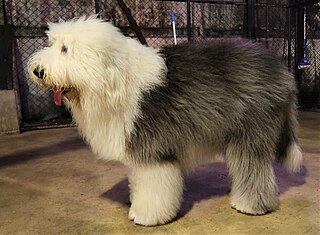
A sheep dog or sheepdog is generally a dog or breed of dogs historically used in connection with the raising of sheep. These include livestock guardian dogs used to guard sheep and other livestock and herding dogs used to move, manage and control sheep and other livestock.

DalslandSwedish pronunciation: [ˈdɑ̌ːlsland] is a Swedish traditional province, or landskap, situated in Götaland in southern Sweden. Lying to the west of Lake Vänern, it is bordered by Värmland to the north, Västergötland to the southeast, Bohuslän to the west, and Norway to the northwest.

The Bullmastiff is a British breed of dog of mastiff type and large size, with a solid build and a short muzzle. It was developed as a guard dog in the nineteenth century by cross-breeding the English Mastiff with the now-extinct Old English Bulldog. It was recognised as a breed by The Kennel Club in 1924.
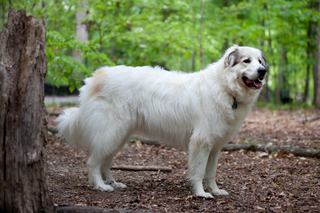
The Pyrenean Mountain Dog (French: Chien de Montagne des Pyrénées) is a breed of livestock guardian dog from France, where it is commonly called the Patou. The breed comes from the French side of the Pyrenees Mountains that separate France and Spain. It is recognised as a separate breed from the closely related Pyrenean Mastiff, which is from the Spanish side of the mountains.

Breeding back is a form of artificial selection by the deliberate selective breeding of domestic animals, in an attempt to achieve an animal breed with a phenotype that resembles a wild type ancestor, usually one that has gone extinct. Breeding back is not to be confused with dedomestication.
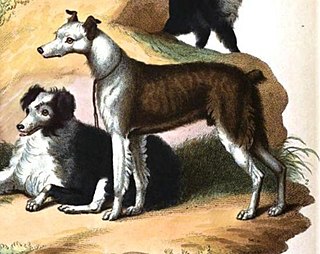
The term cur is usually used to describe a mongrel dog, particularly of aggressive or unfriendly nature. The term is believed to be derived from the Old Norse kurra, meaning 'to grumble or growl'. A short-haired dog used in hunting and herding in the United States is called cur-tailed, or cur for short. A cur was also a now extinct dog breed used by cattle drovers in England.

The Fila Brasileiro, or Brazilian Mastiff, is a large working breed of dog developed in Brazil. It is known for its superb tracking ability, aggressiveness and an unforgiving, impetuous temperament. Rather than attacking its prey, the Fila traps it and waits for the hunter to arrive. Owing to these qualities, the Fila Brasileiro is used as a guard dog, and as a dog fighting dog, as a cattle dog for livestock and as a hunting dog for tracking and controlling large game. When slavery was legal in Brazil in the 18th century, the Fila Brasileiro was used to return fugitive slaves to their masters.
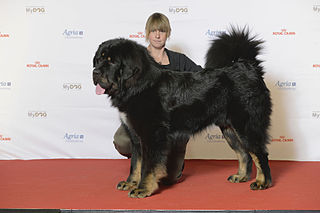
The Tibetan Mastiff is a large size Tibetan dog breed. Its double coat is medium to long, subject to climate, and found in a wide variety of colors, including solid black, black and tan, various shades of red and bluish-gray, and sometimes with white markings around neck, chest and legs. This dog can run up to a speed of 20mph over short distances (32kph).

A guard dog or watchdog is a dog used to watch for and guard property against unwanted or unexpected human or animal intruders.

The Glen of Imaal Terrier is a breed of dog of the terrier category and one of four Irish terrier breeds. It is sometimes called the Irish Glen of Imaal Terrier or the Wicklow Terrier, and the name of the breed is often shortened by fanciers to just Glen.

The Alaunt is an extinct type of dog which came in different forms, with the original possibly having existed in North Caucasus, Central Asia and Europe from ancient times.
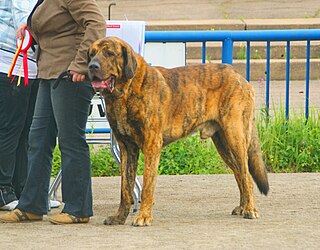
The Spanish Mastiff or Mastín Español is a breed of dog from Spain, originally bred to be a guard dog and whose specialized purpose is to be a livestock guardian dog protecting flocks and/or herds from wolves and other predators.
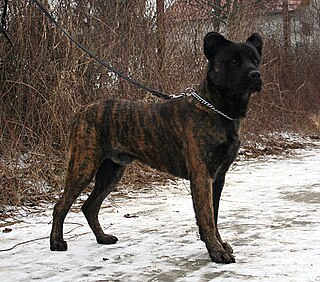
The Saint Miguel Cattle Dog is a dog breed of mastiff type originating on São Miguel Island in the Azores, an island chain which is one of the autonomous regions of Portugal. The breed was originally used as a herding dog for working with cattle.
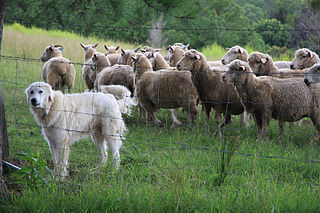
A livestock guardian dog (LGD) is a dog type bred for the purpose of protecting livestock from predators.

The Slovak Cuvac is a Slovak breed of dog, bred for use as a livestock guard dog. This breed—also known as Slovensky Cuvac, Slovak Chuvach, Tatransky Cuvac and Slovensky Kuvac—is closely related to the Hungarian Kuvasz. The alternate German and English spelling Tchouvatch reflects the pronunciation: chew-votch( čuvati - in serbocroatian language - guarding). The breed is recognised under sponsorship from Slovakia by the Fédération Cynologique Internationale with the name Slovenský čuvač. Despite the multiple renderings in English, these refer to only one breed. The United Kennel Club in the US uses the English version of the name Slovak Cuvac.

IFK Strömstad is a Swedish football club located in Strömstad.
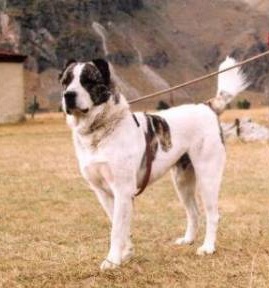
The Georgian Shepherd, also known as Georgian Mountain Dog, is a breed of guard dog and livestock guardian dog from the Georgian Caucasus.

The Cão de Gado Transmontano or Transmontano Mastiff is a breed of livestock guardian dog from Portugal. It originates in the historical province of Trás-os-Montes e Alto Douro in north-eastern Portugal, and is a rare breed confined mostly to this area.
The Bohuskulla is an endangered Swedish breed of hornless mountain cattle. It originates from the area of the Kynnefjäll plateau in northern Bohuslän and Dalsland, in western Sweden. It is a traditional domestic Swedish breed, and derives from a group of cattle discovered in the 1990s in Skepplanda, in Västergötland, close to the border with Bohuslän. Microsatellite analysis has shown it to be closely related to the Fjällko mountain cattle of Sweden.
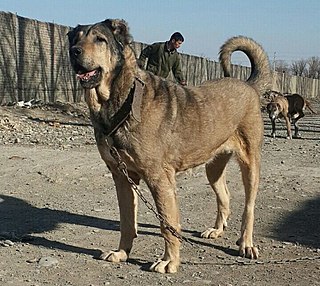
The Sarabi dog, also known as the Persian Mastiff, the Iranian Mastiff, or the Sarabi Mastiff, is a large breed of livestock guardian dog from Iran, originating from the Sarab County, Sarabi dogs have been used for centuries by local shepherds to protect herds of sheep and goats from bears, wolves, jackals and other local predators. The Persian mastiff is calm, controlled, independent, powerful and protective, the breed is also used to compete in staged dog fights. The breed is considered one of the oldest and most powerful indigenous dog breeds in Iran; the larger and heavier an individual dog is, the greater its value.



















